ACC701 Assignment: Auditing and Assurance Adjusting Entries Review
VerifiedAdded on 2023/01/19
|7
|1436
|61
Homework Assignment
AI Summary
This assignment, prepared for ACC701, involves a comprehensive review of financial statements and the proposal of adjusting entries. The analysis covers depreciation of fixed assets, inventory valuation, accounts receivable management, and accounts payable. The student identifies and corrects errors, such as overvalued assets, outdated inventory, uncollected receivables, and understated expenses, referencing International Accounting Standards (IAS) and International Standards on Auditing (ISA). The assignment includes detailed journal entries to rectify the identified issues, ensuring accurate financial reporting and compliance with accounting standards. The student provides explanations for each adjustment, highlighting the impact on financial statements and the importance of proper accounting practices.
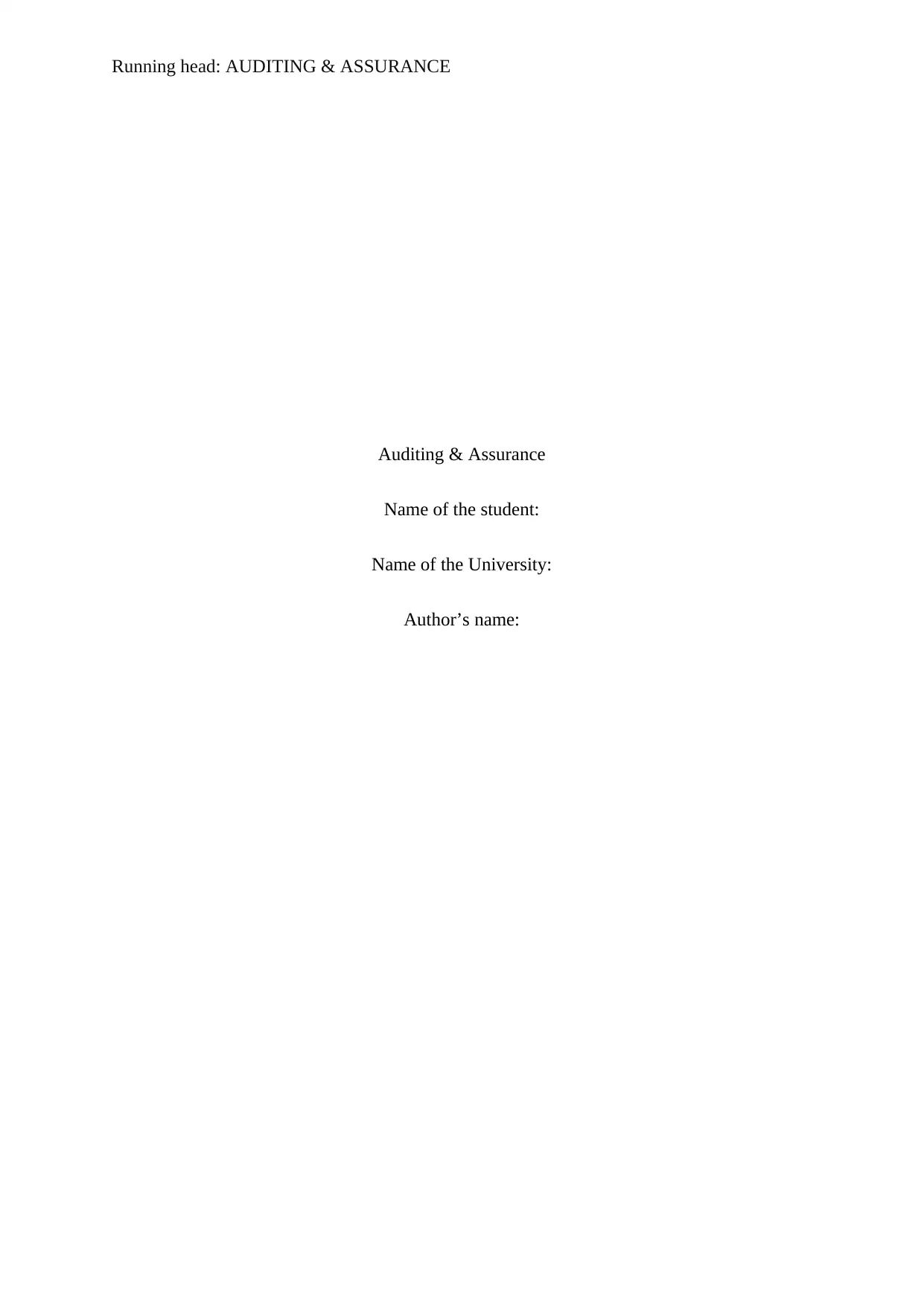
Running head: AUDITING & ASSURANCE
Auditing & Assurance
Name of the student:
Name of the University:
Author’s name:
Auditing & Assurance
Name of the student:
Name of the University:
Author’s name:
Paraphrase This Document
Need a fresh take? Get an instant paraphrase of this document with our AI Paraphraser
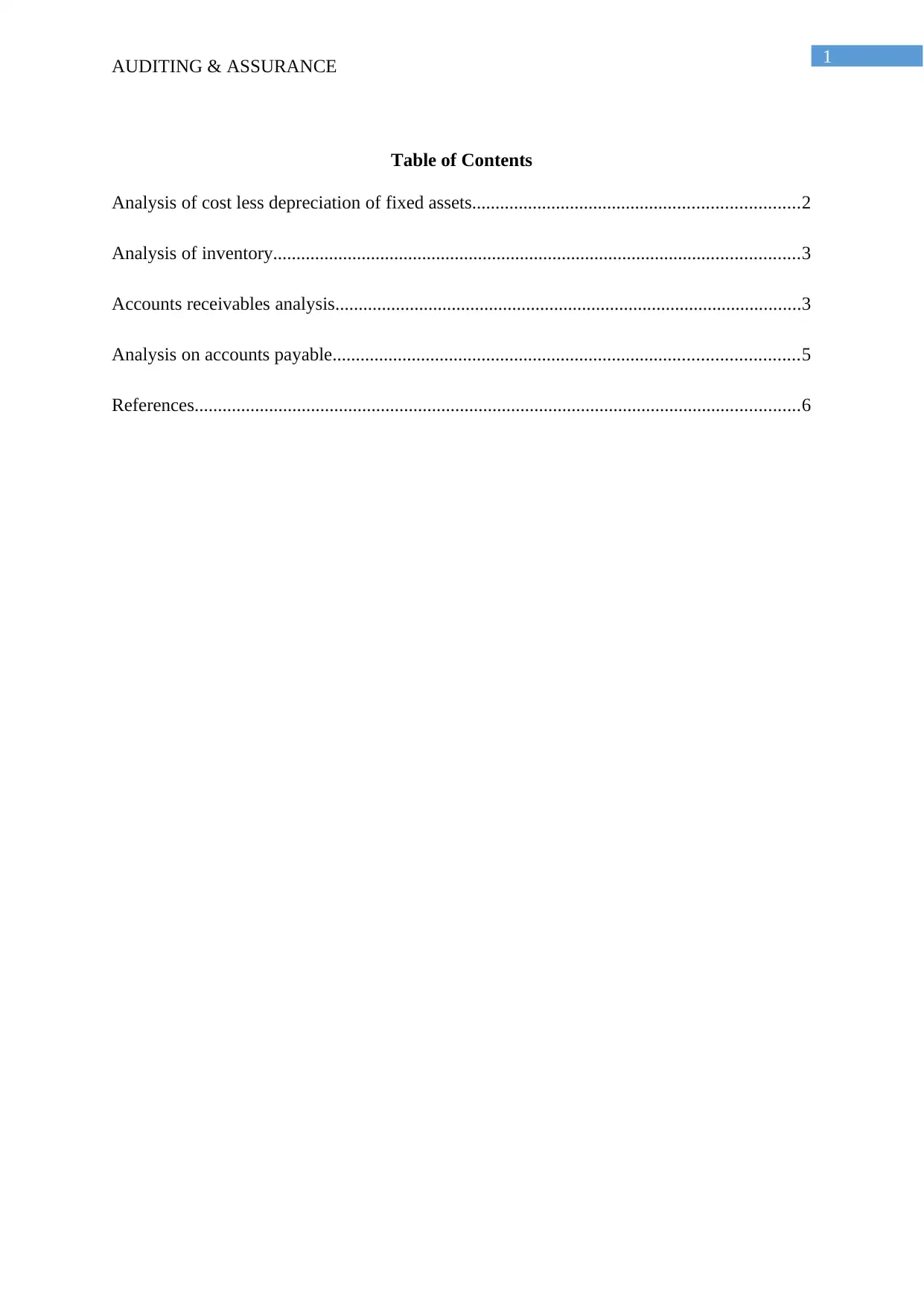
1
AUDITING & ASSURANCE
Table of Contents
Analysis of cost less depreciation of fixed assets......................................................................2
Analysis of inventory.................................................................................................................3
Accounts receivables analysis....................................................................................................3
Analysis on accounts payable....................................................................................................5
References..................................................................................................................................6
AUDITING & ASSURANCE
Table of Contents
Analysis of cost less depreciation of fixed assets......................................................................2
Analysis of inventory.................................................................................................................3
Accounts receivables analysis....................................................................................................3
Analysis on accounts payable....................................................................................................5
References..................................................................................................................................6
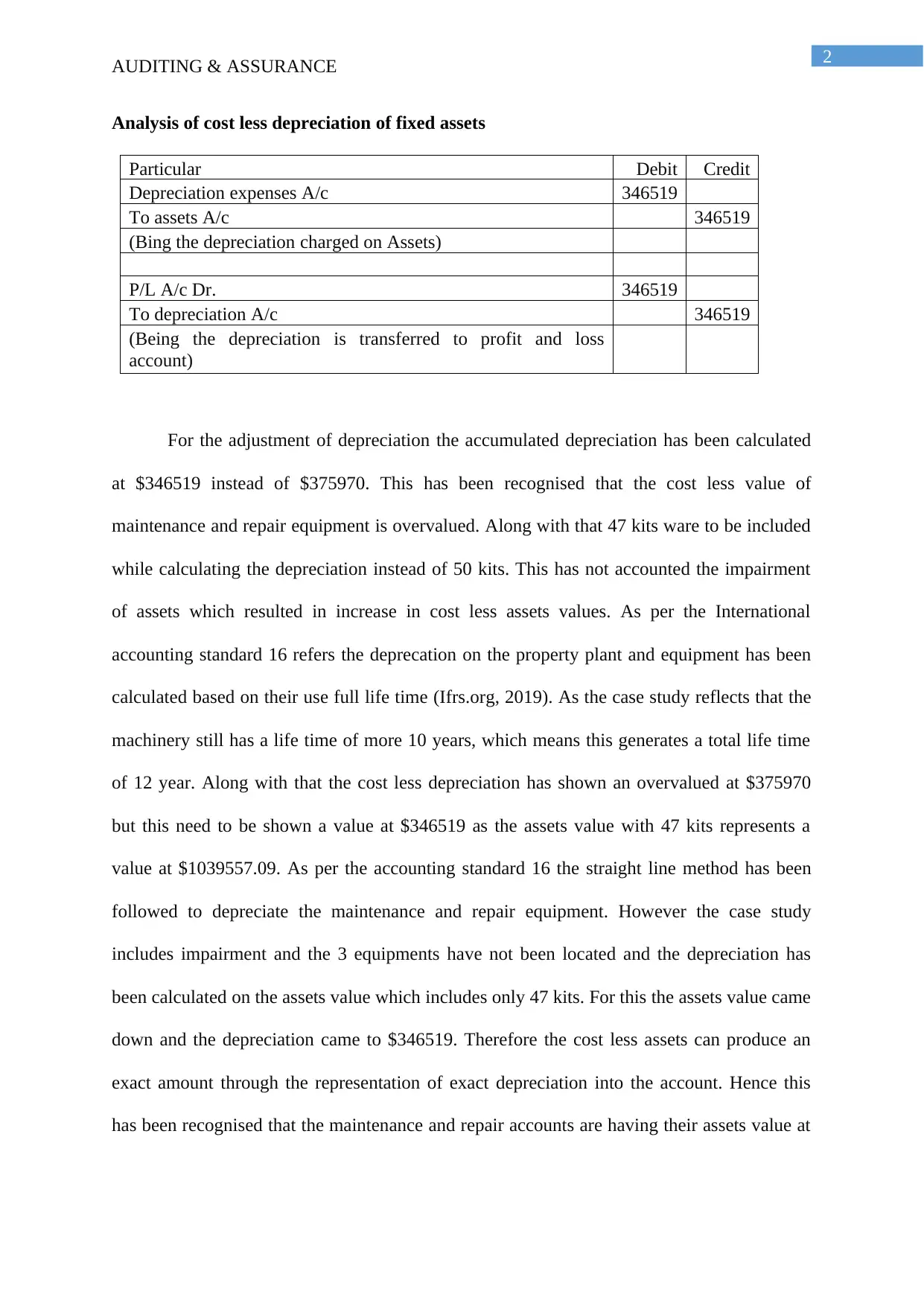
2
AUDITING & ASSURANCE
Analysis of cost less depreciation of fixed assets
Particular Debit Credit
Depreciation expenses A/c 346519
To assets A/c 346519
(Bing the depreciation charged on Assets)
P/L A/c Dr. 346519
To depreciation A/c 346519
(Being the depreciation is transferred to profit and loss
account)
For the adjustment of depreciation the accumulated depreciation has been calculated
at $346519 instead of $375970. This has been recognised that the cost less value of
maintenance and repair equipment is overvalued. Along with that 47 kits ware to be included
while calculating the depreciation instead of 50 kits. This has not accounted the impairment
of assets which resulted in increase in cost less assets values. As per the International
accounting standard 16 refers the deprecation on the property plant and equipment has been
calculated based on their use full life time (Ifrs.org, 2019). As the case study reflects that the
machinery still has a life time of more 10 years, which means this generates a total life time
of 12 year. Along with that the cost less depreciation has shown an overvalued at $375970
but this need to be shown a value at $346519 as the assets value with 47 kits represents a
value at $1039557.09. As per the accounting standard 16 the straight line method has been
followed to depreciate the maintenance and repair equipment. However the case study
includes impairment and the 3 equipments have not been located and the depreciation has
been calculated on the assets value which includes only 47 kits. For this the assets value came
down and the depreciation came to $346519. Therefore the cost less assets can produce an
exact amount through the representation of exact depreciation into the account. Hence this
has been recognised that the maintenance and repair accounts are having their assets value at
AUDITING & ASSURANCE
Analysis of cost less depreciation of fixed assets
Particular Debit Credit
Depreciation expenses A/c 346519
To assets A/c 346519
(Bing the depreciation charged on Assets)
P/L A/c Dr. 346519
To depreciation A/c 346519
(Being the depreciation is transferred to profit and loss
account)
For the adjustment of depreciation the accumulated depreciation has been calculated
at $346519 instead of $375970. This has been recognised that the cost less value of
maintenance and repair equipment is overvalued. Along with that 47 kits ware to be included
while calculating the depreciation instead of 50 kits. This has not accounted the impairment
of assets which resulted in increase in cost less assets values. As per the International
accounting standard 16 refers the deprecation on the property plant and equipment has been
calculated based on their use full life time (Ifrs.org, 2019). As the case study reflects that the
machinery still has a life time of more 10 years, which means this generates a total life time
of 12 year. Along with that the cost less depreciation has shown an overvalued at $375970
but this need to be shown a value at $346519 as the assets value with 47 kits represents a
value at $1039557.09. As per the accounting standard 16 the straight line method has been
followed to depreciate the maintenance and repair equipment. However the case study
includes impairment and the 3 equipments have not been located and the depreciation has
been calculated on the assets value which includes only 47 kits. For this the assets value came
down and the depreciation came to $346519. Therefore the cost less assets can produce an
exact amount through the representation of exact depreciation into the account. Hence this
has been recognised that the maintenance and repair accounts are having their assets value at
⊘ This is a preview!⊘
Do you want full access?
Subscribe today to unlock all pages.

Trusted by 1+ million students worldwide
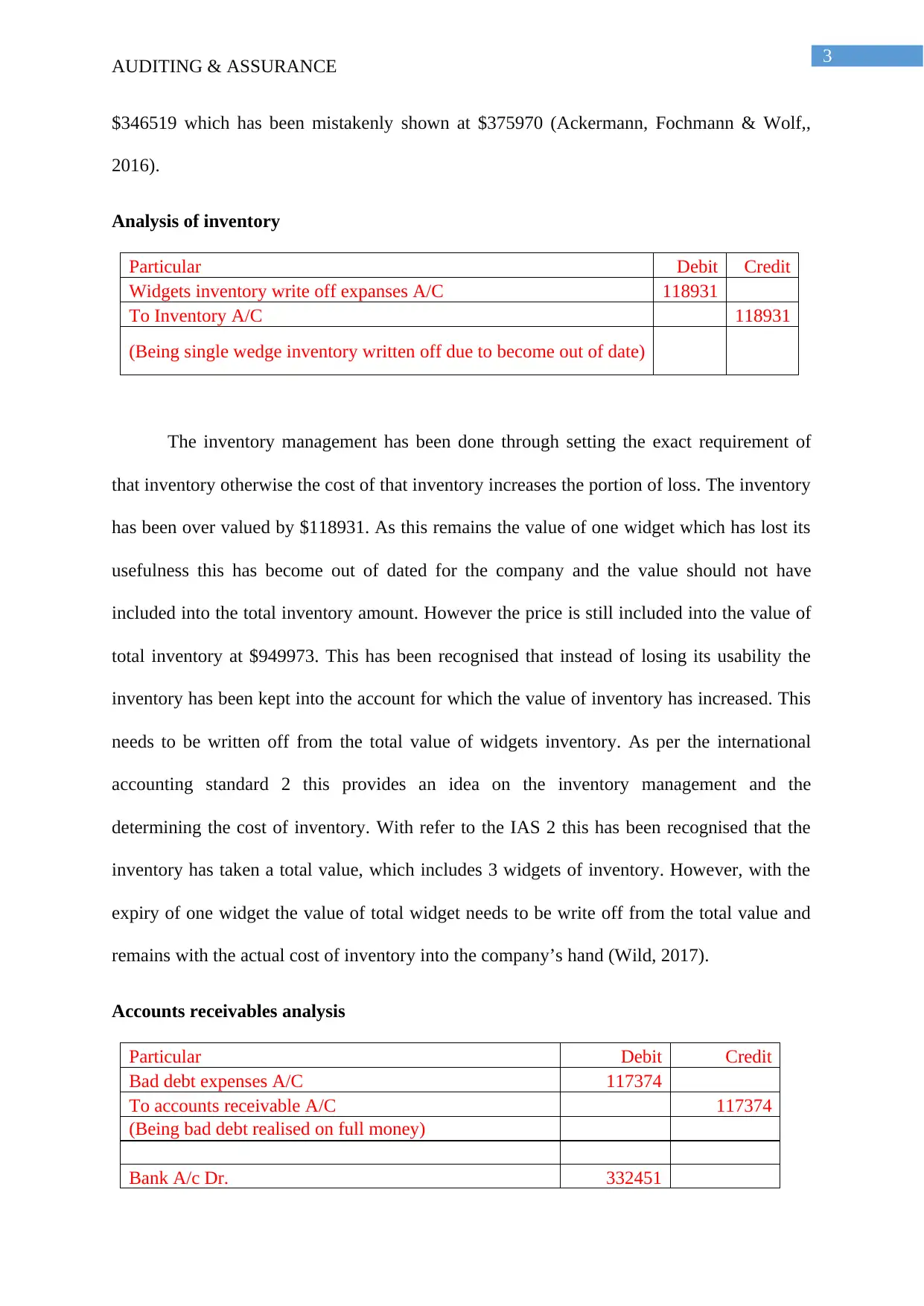
3
AUDITING & ASSURANCE
$346519 which has been mistakenly shown at $375970 (Ackermann, Fochmann & Wolf,,
2016).
Analysis of inventory
Particular Debit Credit
Widgets inventory write off expanses A/C 118931
To Inventory A/C 118931
(Being single wedge inventory written off due to become out of date)
The inventory management has been done through setting the exact requirement of
that inventory otherwise the cost of that inventory increases the portion of loss. The inventory
has been over valued by $118931. As this remains the value of one widget which has lost its
usefulness this has become out of dated for the company and the value should not have
included into the total inventory amount. However the price is still included into the value of
total inventory at $949973. This has been recognised that instead of losing its usability the
inventory has been kept into the account for which the value of inventory has increased. This
needs to be written off from the total value of widgets inventory. As per the international
accounting standard 2 this provides an idea on the inventory management and the
determining the cost of inventory. With refer to the IAS 2 this has been recognised that the
inventory has taken a total value, which includes 3 widgets of inventory. However, with the
expiry of one widget the value of total widget needs to be write off from the total value and
remains with the actual cost of inventory into the company’s hand (Wild, 2017).
Accounts receivables analysis
Particular Debit Credit
Bad debt expenses A/C 117374
To accounts receivable A/C 117374
(Being bad debt realised on full money)
Bank A/c Dr. 332451
AUDITING & ASSURANCE
$346519 which has been mistakenly shown at $375970 (Ackermann, Fochmann & Wolf,,
2016).
Analysis of inventory
Particular Debit Credit
Widgets inventory write off expanses A/C 118931
To Inventory A/C 118931
(Being single wedge inventory written off due to become out of date)
The inventory management has been done through setting the exact requirement of
that inventory otherwise the cost of that inventory increases the portion of loss. The inventory
has been over valued by $118931. As this remains the value of one widget which has lost its
usefulness this has become out of dated for the company and the value should not have
included into the total inventory amount. However the price is still included into the value of
total inventory at $949973. This has been recognised that instead of losing its usability the
inventory has been kept into the account for which the value of inventory has increased. This
needs to be written off from the total value of widgets inventory. As per the international
accounting standard 2 this provides an idea on the inventory management and the
determining the cost of inventory. With refer to the IAS 2 this has been recognised that the
inventory has taken a total value, which includes 3 widgets of inventory. However, with the
expiry of one widget the value of total widget needs to be write off from the total value and
remains with the actual cost of inventory into the company’s hand (Wild, 2017).
Accounts receivables analysis
Particular Debit Credit
Bad debt expenses A/C 117374
To accounts receivable A/C 117374
(Being bad debt realised on full money)
Bank A/c Dr. 332451
Paraphrase This Document
Need a fresh take? Get an instant paraphrase of this document with our AI Paraphraser
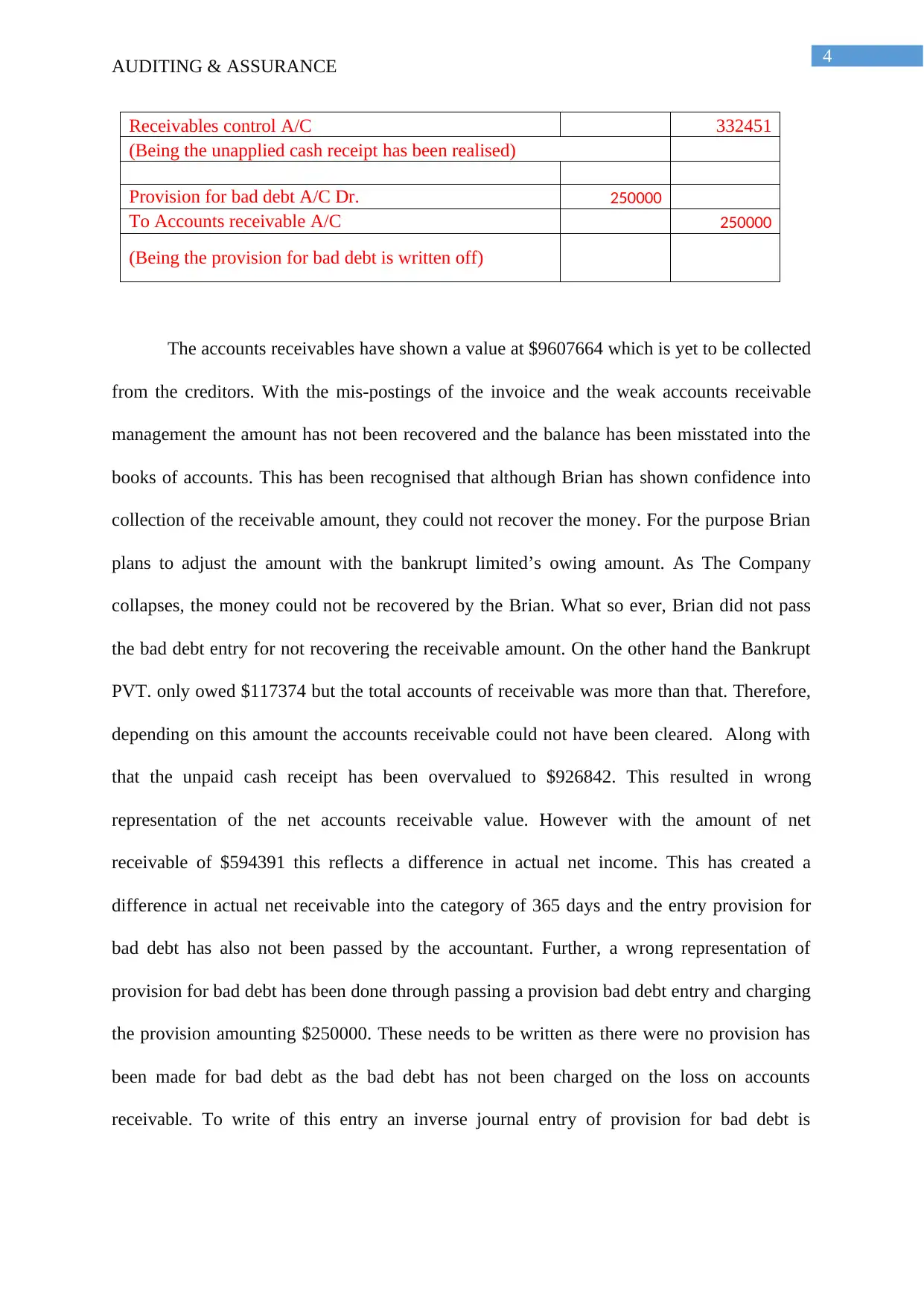
4
AUDITING & ASSURANCE
Receivables control A/C 332451
(Being the unapplied cash receipt has been realised)
Provision for bad debt A/C Dr. 250000
To Accounts receivable A/C 250000
(Being the provision for bad debt is written off)
The accounts receivables have shown a value at $9607664 which is yet to be collected
from the creditors. With the mis-postings of the invoice and the weak accounts receivable
management the amount has not been recovered and the balance has been misstated into the
books of accounts. This has been recognised that although Brian has shown confidence into
collection of the receivable amount, they could not recover the money. For the purpose Brian
plans to adjust the amount with the bankrupt limited’s owing amount. As The Company
collapses, the money could not be recovered by the Brian. What so ever, Brian did not pass
the bad debt entry for not recovering the receivable amount. On the other hand the Bankrupt
PVT. only owed $117374 but the total accounts of receivable was more than that. Therefore,
depending on this amount the accounts receivable could not have been cleared. Along with
that the unpaid cash receipt has been overvalued to $926842. This resulted in wrong
representation of the net accounts receivable value. However with the amount of net
receivable of $594391 this reflects a difference in actual net income. This has created a
difference in actual net receivable into the category of 365 days and the entry provision for
bad debt has also not been passed by the accountant. Further, a wrong representation of
provision for bad debt has been done through passing a provision bad debt entry and charging
the provision amounting $250000. These needs to be written as there were no provision has
been made for bad debt as the bad debt has not been charged on the loss on accounts
receivable. To write of this entry an inverse journal entry of provision for bad debt is
AUDITING & ASSURANCE
Receivables control A/C 332451
(Being the unapplied cash receipt has been realised)
Provision for bad debt A/C Dr. 250000
To Accounts receivable A/C 250000
(Being the provision for bad debt is written off)
The accounts receivables have shown a value at $9607664 which is yet to be collected
from the creditors. With the mis-postings of the invoice and the weak accounts receivable
management the amount has not been recovered and the balance has been misstated into the
books of accounts. This has been recognised that although Brian has shown confidence into
collection of the receivable amount, they could not recover the money. For the purpose Brian
plans to adjust the amount with the bankrupt limited’s owing amount. As The Company
collapses, the money could not be recovered by the Brian. What so ever, Brian did not pass
the bad debt entry for not recovering the receivable amount. On the other hand the Bankrupt
PVT. only owed $117374 but the total accounts of receivable was more than that. Therefore,
depending on this amount the accounts receivable could not have been cleared. Along with
that the unpaid cash receipt has been overvalued to $926842. This resulted in wrong
representation of the net accounts receivable value. However with the amount of net
receivable of $594391 this reflects a difference in actual net income. This has created a
difference in actual net receivable into the category of 365 days and the entry provision for
bad debt has also not been passed by the accountant. Further, a wrong representation of
provision for bad debt has been done through passing a provision bad debt entry and charging
the provision amounting $250000. These needs to be written as there were no provision has
been made for bad debt as the bad debt has not been charged on the loss on accounts
receivable. To write of this entry an inverse journal entry of provision for bad debt is
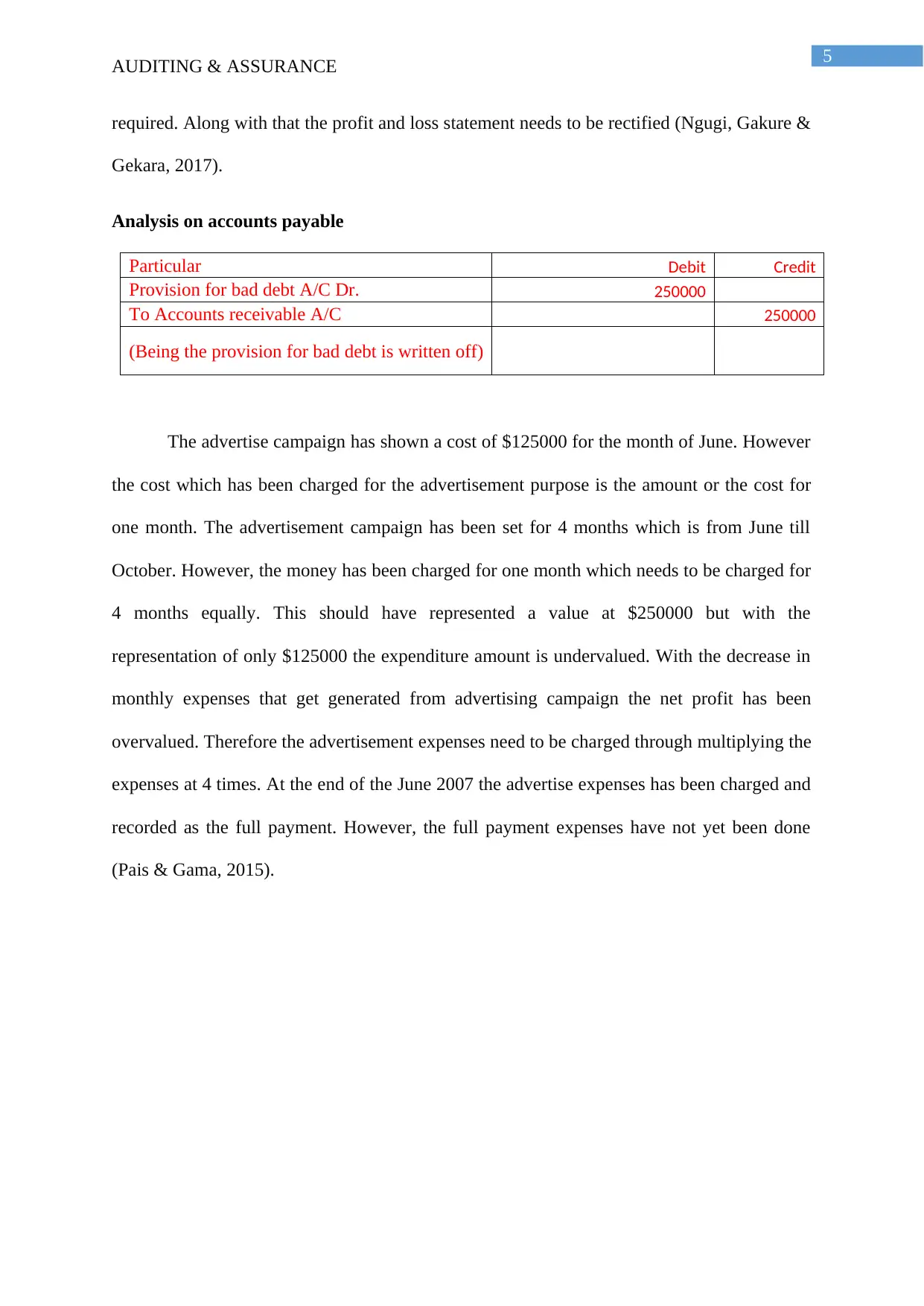
5
AUDITING & ASSURANCE
required. Along with that the profit and loss statement needs to be rectified (Ngugi, Gakure &
Gekara, 2017).
Analysis on accounts payable
Particular Debit Credit
Provision for bad debt A/C Dr. 250000
To Accounts receivable A/C 250000
(Being the provision for bad debt is written off)
The advertise campaign has shown a cost of $125000 for the month of June. However
the cost which has been charged for the advertisement purpose is the amount or the cost for
one month. The advertisement campaign has been set for 4 months which is from June till
October. However, the money has been charged for one month which needs to be charged for
4 months equally. This should have represented a value at $250000 but with the
representation of only $125000 the expenditure amount is undervalued. With the decrease in
monthly expenses that get generated from advertising campaign the net profit has been
overvalued. Therefore the advertisement expenses need to be charged through multiplying the
expenses at 4 times. At the end of the June 2007 the advertise expenses has been charged and
recorded as the full payment. However, the full payment expenses have not yet been done
(Pais & Gama, 2015).
AUDITING & ASSURANCE
required. Along with that the profit and loss statement needs to be rectified (Ngugi, Gakure &
Gekara, 2017).
Analysis on accounts payable
Particular Debit Credit
Provision for bad debt A/C Dr. 250000
To Accounts receivable A/C 250000
(Being the provision for bad debt is written off)
The advertise campaign has shown a cost of $125000 for the month of June. However
the cost which has been charged for the advertisement purpose is the amount or the cost for
one month. The advertisement campaign has been set for 4 months which is from June till
October. However, the money has been charged for one month which needs to be charged for
4 months equally. This should have represented a value at $250000 but with the
representation of only $125000 the expenditure amount is undervalued. With the decrease in
monthly expenses that get generated from advertising campaign the net profit has been
overvalued. Therefore the advertisement expenses need to be charged through multiplying the
expenses at 4 times. At the end of the June 2007 the advertise expenses has been charged and
recorded as the full payment. However, the full payment expenses have not yet been done
(Pais & Gama, 2015).
⊘ This is a preview!⊘
Do you want full access?
Subscribe today to unlock all pages.

Trusted by 1+ million students worldwide

6
AUDITING & ASSURANCE
References
Ackermann, H., Fochmann, M., & Wolf, N. (2016). The Effect of Straight-Line and
Accelerated Depreciation Rules on Risky Investment Decisions—An Experimental
Study. International Journal of Financial Studies, 4(4), 19.
Ifrs.org. (2019). IFRS. Retrieved from https://www.ifrs.org/issued-standards/list-of-
standards/ias-16-property-plant-and-equipment/
Ngugi, S. K., Gakure, R. W., & Gekara, G. M. (2017). Influence of policies on accounts
receivables management in the hotel industry in Kenya. American Journal of
Accounting, 1(1), 93-115.
Pais, M. A., & Gama, P. M. (2015). Working capital management and SMEs profitability:
Portuguese evidence. International Journal of Managerial Finance, 11(3), 341-358.
Wild, T. (2017). Best practice in inventory management. Abingdon: Routledge.
AUDITING & ASSURANCE
References
Ackermann, H., Fochmann, M., & Wolf, N. (2016). The Effect of Straight-Line and
Accelerated Depreciation Rules on Risky Investment Decisions—An Experimental
Study. International Journal of Financial Studies, 4(4), 19.
Ifrs.org. (2019). IFRS. Retrieved from https://www.ifrs.org/issued-standards/list-of-
standards/ias-16-property-plant-and-equipment/
Ngugi, S. K., Gakure, R. W., & Gekara, G. M. (2017). Influence of policies on accounts
receivables management in the hotel industry in Kenya. American Journal of
Accounting, 1(1), 93-115.
Pais, M. A., & Gama, P. M. (2015). Working capital management and SMEs profitability:
Portuguese evidence. International Journal of Managerial Finance, 11(3), 341-358.
Wild, T. (2017). Best practice in inventory management. Abingdon: Routledge.
1 out of 7
Related Documents
Your All-in-One AI-Powered Toolkit for Academic Success.
+13062052269
info@desklib.com
Available 24*7 on WhatsApp / Email
![[object Object]](/_next/static/media/star-bottom.7253800d.svg)
Unlock your academic potential
Copyright © 2020–2025 A2Z Services. All Rights Reserved. Developed and managed by ZUCOL.





